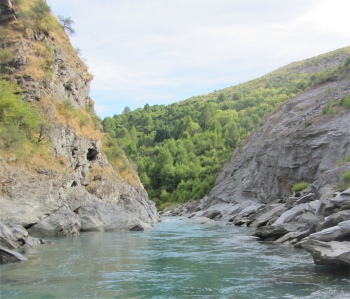
Jetboating up Shotover River
|
Our journey took us part way up to Coronet Peak before we turned off into Skippers Canyon. I could now see first-hand why vehicle insurance companies forbid rental vehicles on this track. It was rough and ready, often proceeding along ledges with vertical drops over the side, and no barriers to prevent an unwary driver from going over. Our guide pointed out mule and horse tracks that the early miners used to take supplies into the valley, and haul their treasure out, ready for the long trip to Dunedin, the nearest port. In its heyday, Dunedin nearly became the capital of New Zealand for this reason.

A Lord of the Rings Location on the Shotover River
|
Formed by glaciers approximately 15 million years ago, loose gravel, rock and gold ground its way down the valley. In this glacial process ton after ton of precious gold was deposited throughout the canyon. Over the years the mighty Shotover River flowed from the Southern Alps and created what would be known as the richest gold bearing river in the world.
In 1862, two Maori shepherds stumbled upon these riches when their sheep dog was washed downstream. Upon finding the dog the shepherds noticed gold on the ground where the dog was standing. That day the two picked up 25 pounds of the precious metal. The gold rush was born.

Mining Relics on Shotover River
|
Within two months there were over four thousand miners in the canyon. Over the next century miners toiled in the harsh environment. Freezing cold winters, blistering hot summers, and flash floods hampered the miners in their quest for gold. It took 22 years to carve out an access road using only black gunpowder and hand drills. This was considered to be an engineering miracle as the road is literally carved out of solid schist rock. Today, the canyon could only boast six residents
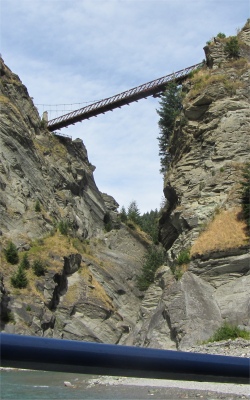
Old Bungy-bridge from the Shotover River
|
Various methods were used to mine for gold such as hard rock mining, dredging, hydraulic elevating and river diversion schemes. The remnants of these schemes are still visible today, with steel flumes, diversion channels and dredger lying alongside the riverbank. Some of these techniques were hugely successful, others were failures.
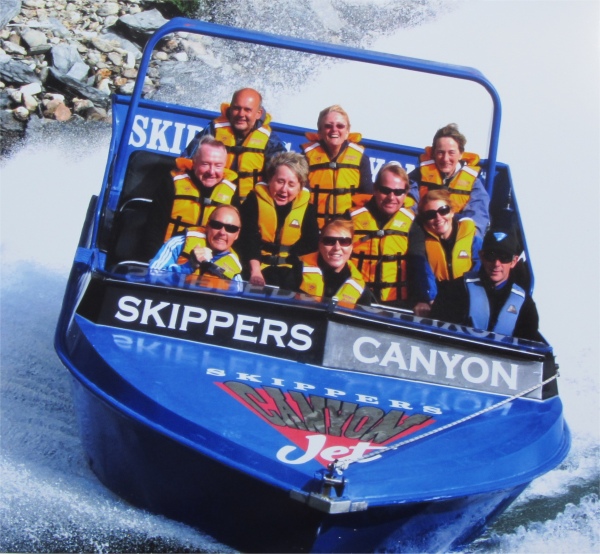
Spot Me in the Jetboat
|
Eventually our winding journey dropped down to beside the Shotover River where we boarded a jetboat for a thrilling ride up and down the river. We were kitted out with life-jackets, just in case somebody fell out of the boat, particularly when we did a 360� turn.
Then we were away, skimming over the clear blue water at speeds up to 70km/hour, with the occasional face full of spray to stop us from falling asleep. The sun had not yet reached the bottom of the valley, so the cold wind that whistled past our faces and bare hands as we hurtled along the gorge soon chilled them to the bone.
The boat required about a metre depth of water when not traveling through the water, but at speed it just required 4" of water, and quite often that was all our skilled pilot had to work with. Our pilot negotiated cliff edges, large boulders and shallow rapids with ease, and I was amazed at how close we flew past some of the jagged vertical edges. The sensation of speed was amazing; we all got a huge buzz from it.
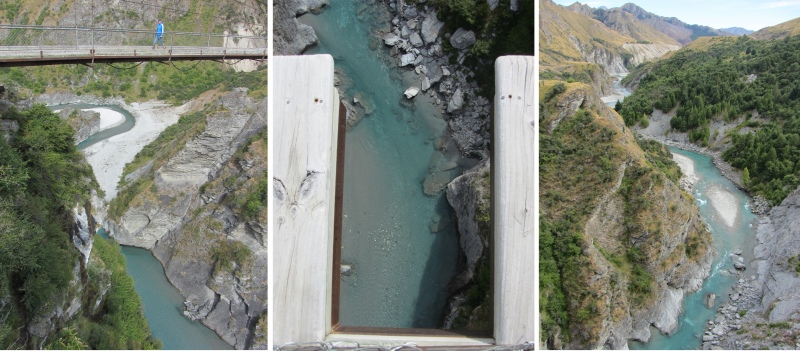
Old Bungy-bridge With the Jumpers View Straight Down
|
We pulled into a section where once a huge dam had been built by the miners. The monstrous steel walls had been twisted and torn by the ravages of the river, and were now scattered along the riverbank. Part of a large dredger also laid half way up a bank. It had been transported from Australia, and carried by horses piecewise up to the canyon and reassembled. It must have all been an impressive sight in its heyday.
High above us at a couple of places were what appeared to be bridges across the canyon. These were in fact bungy-jumping bridges. All too soon we reached the top end of our jetboat journey. It was then a case of turn around and return, but at a faster pace of 80km/hour. My, was that exhilarating. I totally enjoyed the jetboat ride, absolutely out of this world.
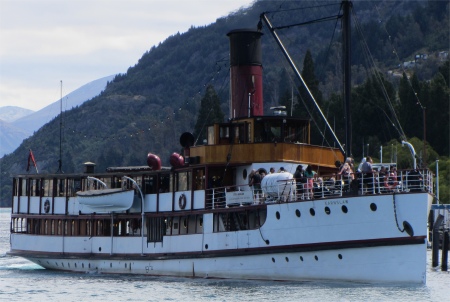
TSS Earnslaw
|
Back on the bus, our driver took us to one of the bungy-jumping bridges, the "Pipeline" suspension bridge, that had ceased to operate some time ago when it wasn't commercially viable for it to continue. The other taller bridge has now taken over the market on the Shotover River.
Most of us walked across the suspended bridge to peer down and wonder what sort of folk leap into the abyss below. It looked pretty down below, but I don't think any of us thought it a sensible thing to do. Each to his own I guess.
On my return to Queenstown, I went down to the waterfront and visited the Underwater Observatory to view the marine life just under the surface of the lake. I was surprised at how large the fish were, including an enormous eel milling around. Looking up I saw the undersides of mallard ducks paddling around.
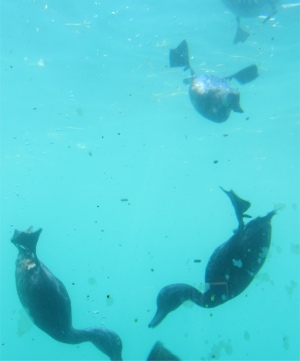
Ducks Diving for Food
|
Every so often a duck would dive down to dredge the bottom of the lake for food, his webbed feet working synchronously as he plummeted head first at considerable speed. On his return to the surface, he would just right himself to his normal horizontal paddling position, and bob up like a cork, crashing through any fish or ducks that may be in his way; quite amusing to watch. A couple of small kids were pumping coins into a machine that dispensed food to the fish. This resulted in a frenzy of activity from both fish and ducks, much to the amusement of the small lads.
I returned back to the surface to have my ears assaulted by the never ending pursuit of pleasure. These frenzied activities within the town spilled out into the surrounding environs of the town, filling valleys and mountains with yelps and screams from dawn to dusk. In the evening, the screams continued in the town accompanied by the thumping base emanating from the countless bars and restaurants. Linking this with the vast Lake Wakatipu was the shrill whistle of TSS
Earnslaw echoing around the mountains, a delightful twin-screw steamer that plied the waters from Queenstown Bay. Launched in 1912, it was named after the highest peak in the region. This was a stately, majestic vessel from a bygone era, gleaming with burnished brass and polished wood.
The Queenstown Gardens, sitting out on a peninsula into the lake, offered some respite from the hoard of tourists. Inside, I came across a massive rock onto which some plaques had been attached. These commemorated Captain Scott and his colleagues, and rather touchingly included his last diary entries before the untimely deaths of that heroic team of explorers.









